Papers by Niels Munksgaard
… in Mass Spectrometry, Jan 1, 2012
CITATIONS 13 READS 38 4 authors:

Plant, cell & environment, Jan 30, 2015
Leaf water contains naturally occurring stable isotopes of oxygen and hydrogen in abundances that... more Leaf water contains naturally occurring stable isotopes of oxygen and hydrogen in abundances that vary spatially and temporally. When sufficiently understood, these can be harnessed for a wide range of applications. Here, we review the current state of knowledge of stable isotope enrichment of leaf water, and its relevance for isotopic signals incorporated into plant organic matter and atmospheric gases. Models describing evaporative enrichment of leaf water have become increasingly complex over time, reflecting enhanced spatial and temporal resolution. We recommend that practitioners choose a model with a level of complexity suited to their application, and provide guidance. At the same time, there exists some lingering uncertainty about the biophysical processes relevant to patterns of isotopic enrichment in leaf water. An important goal for future research is to link observed variations in isotopic composition to specific anatomical and physiological features of leaves that refle...
Hydrological Processes, 2015

PLoS neglected tropical diseases, 2015
Melioidosis is an often fatal infectious disease affecting humans and animals in tropical regions... more Melioidosis is an often fatal infectious disease affecting humans and animals in tropical regions and is caused by the saprophytic environmental bacterium Burkholderia pseudomallei. Domestic gardens are not only a common source of exposure to soil and thus to B. pseudomallei, but they also have been found to contain more B. pseudomallei than other environments. In this study we addressed whether anthropogenic manipulations common to gardens such as irrigation or fertilizers change the occurrence of B. pseudomallei. We conducted a soil microcosm experiment with a range of fertilizers and soil types as well as a longitudinal interventional study over three years on an experimental fertilized field site in an area naturally positive for B. pseudomallei. Irrigation was the only consistent treatment to increase B. pseudomallei occurrence over time. The effects of fertilizers upon these bacteria depended on soil texture, physicochemical soil properties and biotic factors. Nitrates and ure...

Biogeochemistry, 2015
Cave guano derived from insectivorous bats and birds contain unique geochemical and mineralogical... more Cave guano derived from insectivorous bats and birds contain unique geochemical and mineralogical signatures. We investigated the mineralogy, pH, C, N and metal abundance patterns of cave guano spatially and temporally (with depth) along a W-E transect in Malaysia and Palawan from five remote cave sites, each housing large populations of bats and Aerodramus spp.(cave swiftlets). Guano deposits were rich in phosphate and/or sulphate minerals (e.g., gypsum, bassanite) with leucophosphite, spheniscidite, and variscite present in most profiles. Metal abundances measured from modern and ancient bat guano revealed high concentrations of transition metals relative to the local environment. Highly enriched metals, however, were associated with phosphate rather than sulphate minerals. Copper and Zn were enriched in all profiles, whereas other metals were associated with specific caves consistent with known local mineral resources. For example, Sn, Pb, and Rb were particularly enriched in Batu Cave, located in the Peninsular Malaysian granitic tin belt, whereas Ni and Cr were high in regions associated with ultramafic ophiolites and Ni-laterites found on Palawan.
Pesticide, polycyclic aromatic hydrocarbon and metal contamination in the Fitzroy Estuary,

Water, Air, and Soil Pollution, 2009
This study was conducted to determine the metal (Ag, Al, As, Cd, Co, Cu, Fe, Mn, Ni, Pb, Sb, Zn) ... more This study was conducted to determine the metal (Ag, Al, As, Cd, Co, Cu, Fe, Mn, Ni, Pb, Sb, Zn) tolerance and uptake of Mitchell grasses when grown on waste rocks and tailings of a base metal mine, Australia. The objective of conducting such phytoremediation studies was to gain data relating to the implementation and effectiveness of capping and revegetation strategies for mine waste repositories in regions of native grasslands. Pot trials demonstrate that Mitchell grasses are metal tolerant and have the ability to accumulate significant concentrations of metals (Pb, Zn) into their above-ground biomass. Concentrations of metals in Mitchell grasses were evaluated in terms of maximum allowable dietary levels in livestock. The pot trial project revealed that if Mitchell grasses were to be used for mined land reclamation and were grown on tailings, the grasses could potentially accumulate large quantities of Zn in their tissue, potentially causing harmful effects on animals feeding on them. Hence, it is undesirable that Mitchell grasses are grown on and their root system come in contact with tailings with elevated level of Zn. Otherwise, the species may accumulate phyto-and zootoxic concentrations of Zn. The metal tolerance, the tendency to accumulate metals in the above-ground biomass and the significant root penetration depth of Mitchell grasses have implications for the design of tailings storage facilities. Capping of waste repositories, containing elevated metal concentrations and using a cover system without capillary breaks, clay layers or alternative strategies, may not be sustainable in the long term. The application of phosphate amendments to tailings may represent an alternative strategy to limit the uptake of metals by Mitchell grasses. The pot trials prove that the addition of phosphate to mine wastes decreases the bio-availability of metals in these materials and reduces the Pb and Zn concentration in Mitchell grasses growing on them. Thus, the addition of phosphate amendments to the top layers of metalliferous mine wastes may represent an alternative waste management strategy.
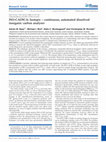
Rapid Communications in Mass Spectrometry, 2012
RATIONALE: Quantifying the processes that control dissolved inorganic carbon (DIC) dynamics in aq... more RATIONALE: Quantifying the processes that control dissolved inorganic carbon (DIC) dynamics in aquatic systems is essential for progress in ecosystem carbon budgeting. The development of a methodology that allows high-resolution temporal data collection over prolonged periods is essential and is described in this study. METHODS: A novel sampling instrument that sequentially acidifies aliquots of water and utilises gas-permeable ePTFE tubing to measure the dissolved inorganic carbon (DIC) concentration and d 13 C DIC values at sub-hourly intervals by Cavity Ring-down spectrometry (CRDS) is described. RESULTS: The minimum sensitivity of the isotopic, continuous, automated dissolved inorganic carbon analyser (ISO-CADICA) system is 0.01 mM with an accuracy of 0.008 mM. The analytical uncertainty in d 13 C DIC values is proportional to the concentration of DIC in the sample. Where the DIC concentration is greater than 0.3 mM the analytical uncertainty is AE0.1 % and below 0.2 mM stability is < AE 0.3 %. The isotopic effects of air temperature, water temperature and CO 2 concentrations were found to either be negligible or correctable. Field trials measuring diel variation in d 13 C DIC values of coral reef associated sea water revealed significant, short-term temporal changes and illustrated the necessity of this technique. CONCLUSIONS: Currently, collecting and analysing large numbers of samples for d 13 C DIC measurements is not trivial, but essential for accurate carbon models, particularly on small scales. The ISO-CADICA enables on-site, high-resolution determination of DIC concentration and d 13 C DIC values with no need for sample storage and laboratory analysis. The initial tests indicate that this system can offer accuracy approaching that of traditional IRMS analysis. Copyright

Marine Ecology Progress Series, 2011
We compare vertebral microchemistry with previously described age-related movement patterns of bu... more We compare vertebral microchemistry with previously described age-related movement patterns of bull sharks Carcharhinus leucas and pig-eye sharks C. amboinensis within coastal waters of north Australia. Laser ablation inductively coupled plasma mass spectrometry (LA-ICP-MS) quantified the chemical signatures of nursery habitats within the vertebrae of juvenile and adult sharks. We examined evidence for adults returning to these habitats by applying LA-ICP-MS along a growth axis of their vertebrae. We transposed chemical signatures with growth increments in adult vertebrae to correlate with age estimates. Unique elemental signatures were identified in each of the freshwater nurseries, but we did not find them in adult vertebrae. Age-specific changes in vertebral microchemistry in mature female bull sharks correlate with periodic returns every 1 to 2 yr to less saline environments to pup. We were unable to discriminate among natal habitats of pig-eye sharks using elemental fingerprints, and age-specific changes in vertebral microchemistry were also absent. We conclude that changes in vertebral microchemistry correlate with known habitat use patterns of the bull and pig-eye sharks, showing the potential of vertebral microchemistry to discern movement patterns in sharks.
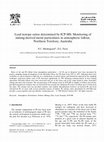
Rates of Zn and Pb fallout from atmospheric particulates) 1020 m in diameter have been measured b... more Rates of Zn and Pb fallout from atmospheric particulates) 1020 m in diameter have been measured by passive sampling during development of the McArthur River ZnrPb mine from 1993 to 1997. Although short-term variability at a given location is high due to a combination of natural factors and limitations imposed by the sampling technique, long-term fallout rates of Pb increased significantly in 1995 following commencement of local mining operations. Recently fallout rates have decreased and are at the lower end of the range found in other Australian mining and inner-city locations. The measurement of Pb isotope ratios by ICP-MS in samples of fallout and soil has provided unequivocal evidence that ore-derived Pb has become the dominant Pb source in fallout up to 8.6 km from the mine. The isotope data has provided sensitive and reliable discrimination between ore-derived Pb and local soil-derived Pb. In areas with several potential sources of fallout, Pb isotope ratios determined by ICP-MS may provide a source-specific and cost-effective monitoring tool.
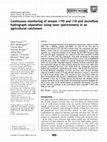
A portable Wavelength Scanned-Cavity Ring-Down Spectrometer (Picarro L2120) fitted with a diffusi... more A portable Wavelength Scanned-Cavity Ring-Down Spectrometer (Picarro L2120) fitted with a diffusion sampler (DS-CRDS) was used for the first time to continuously measure δ 18 O and δ 2 H of stream water. The experiment took place during a storm event in a wet tropical agricultural catchment in northeastern Australia. At a temporal resolution of one minute, the DS-CRDS measured 2160 δ 18 O and δ 2 H values continuously over a period of 36 h with a precision of ±0.08 and 0.5‰ for δ 18 O and δ 2 H, respectively. Four main advantages in using high temporal resolution stream δ 18 O and δ 2 H data during a storm event are highlighted from this study. First, they enabled us to separate components of the hydrograph, which was not possible using high temporal resolution electrical conductivity data that represented changes in solute transfers during the storm event rather than physical hydrological processes. The results from the hydrograph separation confirm fast groundwater contribution to the stream, with the first 5 h of increases in stream discharge comprising over 70% pre-event water. Second, the high temporal resolution stream δ 18 O and δ 2 H data allowed us to detect a short-lived reversal in stream isotopic values (δ 18 O increase by 0.4‰ over 9 min), which was observed immediately after the heavy rainfall period. Third, δ 18 O values were used to calculate a time lag of 20 min between the physical and chemical stream responses during the storm event. Finally, the hydrograph separation highlights the role of event waters in the runoff transfers of herbicides and nutrients from this heavily cultivated catchment to the Great Barrier Reef.

Marine Pollution Bulletin, 1998
Lead isotope ratios and concentrations have been measured in seawater and marine sediment by Indu... more Lead isotope ratios and concentrations have been measured in seawater and marine sediment by Inductively Coupled Plasma Mass Spectrometry (ICP-MS). For seawater, solvent extraction pre-concentration and the use of a micro-concentric nebulizer allowed 1 ml of concentrate to be measured for several minutes to achieve precisions in the range 0.5-1.2% relative standard deviation for 208Pb/206Pb and 207Pb/206Pb. The environmental dispersion of trace amounts of anthropogenic Pb produced distinctive Pb isotope ratio changes in seawater and marine sediments in the immediate vicinity of a PbZn concentrate shipping facility. Concentrate was found to have 208Pb/206Pb ratios in the range 2.21-2.25, whereas environmental background 208Pb/206Pb ratios were: filtered (< 0.45 μm) seawater, 2.13-2.15; unfiltered seawater, 2.06-2.10; sediment, 2.06-2.09. The combined Pb isotope ratio and concentration measurements by ICP-MS have provided a sensitive and cost effective monitoring tool allowing an unambiguous assessment of the source of Pb.
Journal of Analytical Atomic Spectrometry, 1997
An off-line solvent extraction procedure with inductively coupled plasma mass spectrometric (ICP-... more An off-line solvent extraction procedure with inductively coupled plasma mass spectrometric (ICP-MS) determination was developed for the determination of heavy metals in sea-water at ultra-trace levels. The procedure was adapted from a dithiocarbamatediisobutyl ketone solvent ...
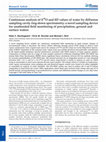
Rapid communications in mass spectrometry : RCM, Jan 30, 2011
A novel sampling device suitable for continuous, unattended field monitoring of rapid isotopic ch... more A novel sampling device suitable for continuous, unattended field monitoring of rapid isotopic changes in environmental waters is described. The device utilises diffusion through porous PTFE tubing to deliver water vapour continuously from a liquid water source for analysis of d 18 O and dD values by Cavity Ring-Down Spectrometry (CRDS). Separation of the analysed water vapour from non-volatile dissolved and particulate contaminants in the liquid sample minimises spectral interferences associated with CRDS analyses of many aqueous samples. Comparison of isotopic data for a range of water samples analysed by Diffusion Sampling-CRDS (DS-CRDS) and Isotope Ratio Mass Spectrometry (IRMS) shows significant linear correlations between the two methods allowing for accurate standardisation of DS-CRDS data. The internal precision for an integration period of 3 min (standard deviation (SD) = 0.1 % and 0.3 % for d 18 O and dD values, respectively) is similar to analysis of water by CRDS using an autosampler to inject and evaporate discrete water samples. The isotopic effects of variable air temperature, water vapour concentration, water pumping rate and dissolved organic content were found to be either negligible or correctable by analysis of water standards. The DS-CRDS system was used to analyse the O and H isotope composition in short-lived rain events. Other applications where finely time resolved water isotope data may be of benefit include recharge/discharge in groundwater/river systems and infiltration-related changes in cave drip water.
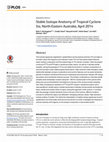
PloS one, 2015
The isotope signatures registered in speleothems during tropical cyclones (TC) provides informati... more The isotope signatures registered in speleothems during tropical cyclones (TC) provides information about the frequency and intensity of past TCs but the precise relationship between isotopic composition and the meteorology of TCs remain uncertain. Here we present continuous δ 18 O and δ 2 H data in rainfall and water vapour, as well as in discrete rainfall samples, during the passage of TC Ita and relate the evolution in isotopic compositions to local and synoptic scale meteorological observations. High-resolution data revealed a close relationship between isotopic compositions and cyclonic features such as spiral rainbands, periods of stratiform rainfall and the arrival of subtropical and tropical air masses with changing oceanic and continental moisture sources. The isotopic compositions in discrete rainfall samples were remarkably constant along the~450 km overland path of the cyclone when taking into account the direction and distance to the eye of the cyclone at each sampling time. Near simultaneous variations in δ 18 O and δ 2 H values in rainfall and vapour and a near-equilibrium rainfall-vapour isotope fractionation indicates strong isotopic exchange between rainfall and surface inflow of vapour during the approach of the cyclone. In contrast, after the passage of spiral rainbands close to the eye of the cyclone, different moisture sources for rainfall and vapour are reflected in diverging d-excess values. High-resolution isotope studies of modern TCs refine the interpretation of stable isotope signatures found in speleothems and other paleo archives and should aim to further investigate the influence of cyclone intensity and longevity on the isotopic composition of associated rainfall.
... Queensland, Australia. Lottermoser, Bernd G., Ashley, Paul, and Munksgaard, Niels C. (2007) B... more ... Queensland, Australia. Lottermoser, Bernd G., Ashley, Paul, and Munksgaard, Niels C. (2007) Biogeochemistry and geobotany of Pb-Zn gossans, northwest Queensland, Australia. ... 100%. SEO Codes: 84 MINERAL RESOURCES (excl. Energy ...
Queensland Roads of Australia is planning for an upgrade to a four-lane surface route on the 14km... more Queensland Roads of Australia is planning for an upgrade to a four-lane surface route on the 14km section of the Kennedy Highway between Cairns and Kuranda (known locally as Kuranda Range Road) in Far North Queensland. The road links the coastal plains of Cairns to the ...










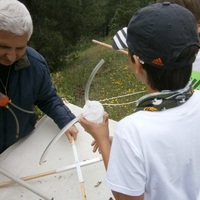
Uploads
Papers by Niels Munksgaard